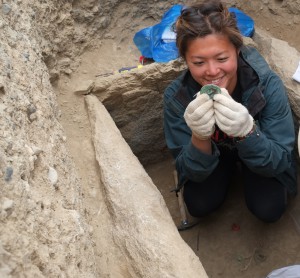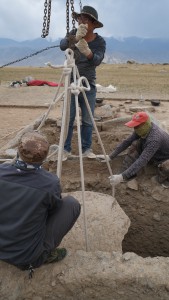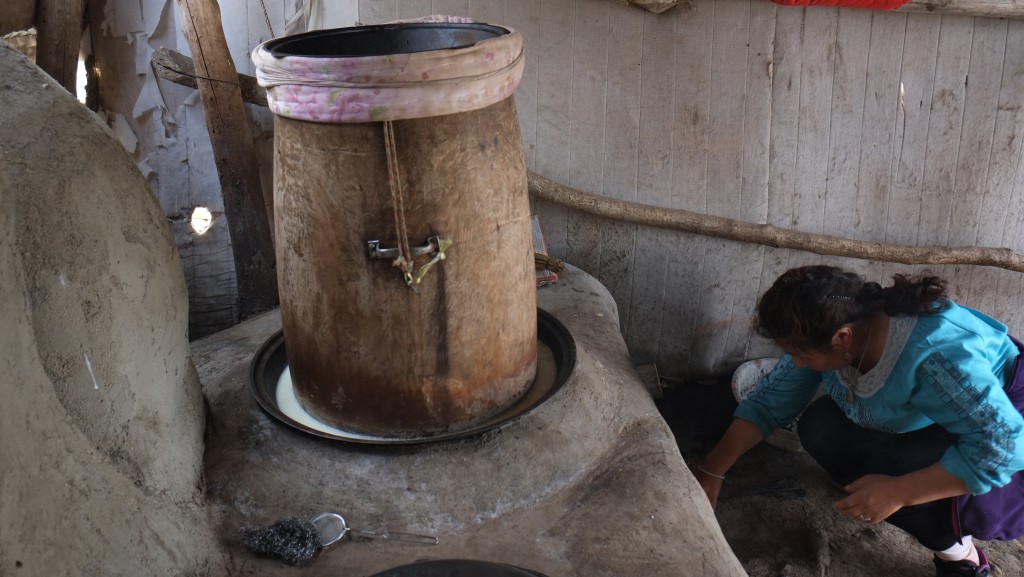From: Penn Blog
As we approach the end of the field season, with 2 weeks remaining, the cold weather also begins to settle in. Since I last wrote, the grass has yellowed, leaving flocks of sheep and cow to scavenge from what is left from a summer much drier than prior years. The rainmakers had to be called in to induce precipitation by dispersing silver iodide into the clouds.
We are currently excavating the twenty graves we exposed at the site of Adonqolu this season. The site lies on the gentle south-facing slopes between two mountain ranges (please refer to my previous post for description). The graves are all oriented east-west with their capstones arranged generally in a north-south direction. They are lined with, most commonly, erect stone slabs on all four sides of the grave, and they sit inside quadrangular structures outlined by either erect stone slabs or flat-lying stones. Graves in the same enclosure may be dated to different time periods, and this chronological gap can be discerned by observing the stratigraphy as well as structural configurations. To understand their spatial arrangement and chronological relationship, we are also creating 3D reconstruction models using a photogrammetry software. All archaeological findings are shot in with a total station and the distribution of finds will be correlated with the structures in three dimensional space.
 Besides gazing at human crania with Europoid features, the other highlight of my fieldwork has been the bronze objects I excavated in one of the graves, which include bronze beads, bronze bracelets/anklets, small bronze ornaments that might have been affixed to clothing, and what look like bronze mirrors (see picture at left). What is also interesting is that the bronze objects are mixed in a concentrated deposit of burnt human bones. Unlike this grave, most other graves yielded flat bottomed ceramic pots with incised patterns (picture below) that can be attributed to the Andronovo Culture of Central Asia, bronze objects are limited to one or two pieces if not absent. Where the bones of the deceased have been preserved, they are usually placed in a fetal position with the head facing north in the western end of the grave. Secondary burials have also been found.
Besides gazing at human crania with Europoid features, the other highlight of my fieldwork has been the bronze objects I excavated in one of the graves, which include bronze beads, bronze bracelets/anklets, small bronze ornaments that might have been affixed to clothing, and what look like bronze mirrors (see picture at left). What is also interesting is that the bronze objects are mixed in a concentrated deposit of burnt human bones. Unlike this grave, most other graves yielded flat bottomed ceramic pots with incised patterns (picture below) that can be attributed to the Andronovo Culture of Central Asia, bronze objects are limited to one or two pieces if not absent. Where the bones of the deceased have been preserved, they are usually placed in a fetal position with the head facing north in the western end of the grave. Secondary burials have also been found.
Since our day is long, starting normally at 9am when the moon still hangs high in the sky, and ending at 8pm when the evening sun is still above the horizon, we take a siesta in our Mongol yurts with a pot of traditional milk tea. In the month of August, the weather has varied from tank top and shorts to thermal wear with fleece and wind jacket. The strong winds in the mountains are unrelenting at times, leaving us covered completely in dirt at the excavation site. Teamwork is one of the most paramount aspects of archaeological fieldwork, and I am privileged to have worked with a team that has held its own through rain and shine.
While I find the hospitality of the herds equalling endearing as their owners, my companions beg to differ – we often find cows and camels roaming near our site, finding their way into our latrines and once, through our kitchen. They are also the most unperturbed pedestrians, they would stroll into the middle of the road at the most inopportune moments. But to be fair, this vast area of grassland is their home and we are the trespassers. They are the livelihood of many Mongols and Kazakhs who practice pastoralism in the area today, and most of whom I met have enthusiastically showed me their lifeways. I learnt how they make milk products including yoghurt, butter, hard cheese, and what they call milk wine (you add a dollop of butter and drink it hot!), all products derived from animal husbandry. They also showed me how to felt by hand. With increased industrialization, these traditional skills are gradually losing their limelight; it is also difficult for the pastoralists to keep making these products once they move into the urban environment, these processes require communal effort, an outdoor setting, and tools that cannot be found in stores. As I made these observations, it became more apparent to me the importance of documenting these activities before the skill sets are completely forgone by future generations.
[My summer fieldwork is supported by grants from the Henry Luce Foundation/ACLS and the Penn Museum.]








No comments:
Post a Comment